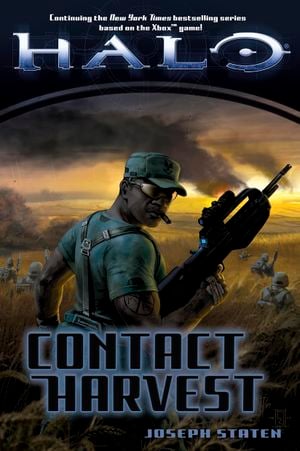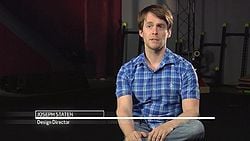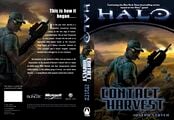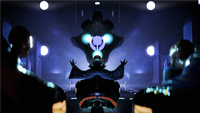Halo: Contact Harvest
From Halopedia, the Halo wiki
| Halo: Contact Harvest | |
|---|---|

| |
| Attribution information | |
|
Author(s): |
|
| Publication information | |
|
Publisher: |
Tor Books[1] |
|
Publication date: |
October 30, 2007 (original)[1] |
|
Media type: |
Paperback[1] |
|
Pages: |
400 pages (original)[1] |
|
ISBN: |
|
- "The title says it all: it’s the story of “first contact” between the Covenant and us."
- — Joseph Staten[2]
Halo: Contact Harvest is a Halo novel written by Joseph Staten, a writer for the original Halo trilogy of games.[2] Published by Tor Books, Contact Harvest was released on October 30, 2007 and is the fifth official book in the Halo series, the second of three that were published by Tor.[1] Contact Harvest is Staten's first published novel, which he wrote after he was approached by Tor.[2] The novel was generally well-received following its release and remained on The New York Times Best Sellers list at #3 for four weeks.[3]
Set between 2524 and 2525, Contact Harvest details the first contact between humanity and the Covenant on the Outer Colony planet of Harvest, as well as the events leading to the beginning of the Human-Covenant War. Staten described the novel as an "ensemble piece", as Contact Harvest is narrated from the points-of-view of both human and Covenant characters. The novel centers around a young UNSC Marine, Staff Sergeant Avery Johnson—a popular and major recurring character that appears throughout the Halo series.[2]
Halo: Contact Harvest, along with Ghosts of Onyx and The Cole Protocol, was released as part of the Halo Boxed Set on March 2, 2010.[4]
Official summary[edit]
| “ | This is how it began…
It is the year 2524. Harvest is a peaceful, prosperous farming colony on the very edge of human-controlled space. But we have trespassed on holy ground--strayed into the path of an aggressive alien empire known as the Covenant. What begins as a chance encounter between an alien privateer and a human freighter catapults mankind into a struggle for its very existence. But humanity is also locked in a bitter civil war known as the Insurrection. So the survival of Harvest's citizens falls to a squad of battle-weary UNSC Marines and their inexperienced colonial militia trainees. In this unlikely group of heroes, one stands above the rest… a young Marine staff sergeant named Avery Johnson.[1] |
” |
Plot synopsis[edit]
Following a failed anti-insurrectionist operation on the human Inner Colony of Tribute which leaves most of his unit killed, the UNSC Marine Staff Sergeant Avery Johnson is sent on leave in the Greater Chicago Industrial Zone on Earth. When going to visit his aunt in a retirement home, he is shocked to discover her dead. As a result, he goes on a drinking spree. He eventually ends up being reassigned to the remote agriculture world of Harvest to get away from the frontlines of the Insurrection. Much to his surprise, he finds his former squad mate, Staff Sergeant Byrne, assigned there as well.
On Harvest, there is only peace and prosperity. Watched by two artificial intelligences, Sif and Mack, the colony produces much of humanity's food. Under the supervision of Captain Ponder, Johnson, Byrne, and Hospital Corpsman Healy are tasked with raising a militia to protect Harvest from the growing threat of the Insurrection. This peace is interrupted when a Covenant missionary ship, Minor Transgression, discovers a malfunctioning unmanned human cargo ship. The coordinates registered in the cargo ship's navigation computer lead the aliens to Harvest. An Unggoy deacon, Dadab, is alarmed when the ship's Luminary seems to register thousands of Forerunner artifacts and an Oracle. The opportunistic Kig-Yar plan to take some artifacts for themselves before reporting the discovery to the Hierarchs, and begin surreptitiously raiding human freighters. The first meeting between a human and member of the Covenant takes place aboard the manned human freighter This End Up in January 2525. While Henry Gibson, captain of the freighter, attempts to kill Dadab, he is killed by the Huragok Lighter Than Some. Unfortunately for the Kig-Yar, the Office of Naval Intelligence has recently organized a strike team to counteract what they believe to be a growing insurrectionist group. Under the command of Lieutenant Commander Jilan al-Cygni, Johnson and Byrne await for the expected insurgents aboard freighter Bulk Discount. They successfully deceive the crew of Minor Transgression into boarding the freighter, where they are immediately attacked by Johnson and Byrne. Johnson receives a cracked skull from their meeting and Byrne is stabbed in the leg with an energy cutlass, though the humans manage to defeat the Kig-Yar boarders. This raid marks the second meeting of the humans and Covenant forces, and makes the humans aware of a brand new threat they may be facing. The Kig-Yar vessel's self-destruction sequence is activated by its dying shipmistress, and Johnson and Byrne barely manage to escape the resulting explosion. Among the missionary ship's crew, only Dadab and his Huragok friend Lighter Than Some flee the destruction of their ship aboard an escape pod.
While Ponder, Johnson, Byrne, and Healy work to prepare the Harvest militia for a possible alien invasion, the San'Shyuum Minister of Fortitude is confronted by the Vice Minister of Tranquility on High Charity. The Vice Minister reveals the discovery of the large amount of "relics" found on Harvest and, after some convincing, Fortitude agrees to initiate a coup of the current Hierarchs with Tranquility, using the Vice Minister's discovery as a fulcrum. To keep the Sangheili from using this discovery as a way to upset the balance of power, they utilize a Jiralhanae-controlled ship, Rapid Conversion, captained by Chieftain Maccabeus and crewed by his clan of Jiralhanae—including a youthful Tartarus, the chieftain's nephew. Rapid Conversion arrives in the system and discovers the escape pod containing Dadab and Lighter Than Some. Maccabeus is delighted to have a Huragok aboard his cruiser, as the Sangheili only permit Jiralhanae ships to employ Yanme'e workers in maintenance roles. Maccabeus tasks Lighter Than Some with making repairs to the ship's weaponry, which was disabled by the Sangheili. Meanwhile, the Yanme'e are relegated to menial roles or combat positions, much to their chagrin. The chieftain uses the deacon as a way to motivate the cruiser's own lackluster complement of Unggoy. Upon arriving at the planet, the crew of Rapid Conversion soon discover Harvest's vast store of Forerunner relics and a message of peace left by Sif and Mack in the form of a crude pictogram displaying a desire for peace. Their Luminary also indicates that there is an Oracle on the planet. The Jiralhanae land two Spirit dropships at the specified date to meet with the human peace delegates, though the Jiralhanae only desire to capture the entire planet and its relics. The peace talks falls apart after an errant Unggoy attacks and kills Harvest militiaman Osmo, and the one-sided Battle of Harvest begins.
Meanwhile, the ambitious San'Shyuum begin their mutiny of sorts by invoking the High Prophet of Restraint in a conspiracy that will lead to his removal if revealed. However, in order to ascend to the throne of Hierarch, the two require a blessing from the long-silent Oracle present on the Forerunner Dreadnought within High Charity. They visit an old, supposedly senile Philologist for his blessings and advice. When they input the discovery of Harvest and the Luminary's data, the Oracle—which is in fact a fragment of the Forerunner Contender-class AI Mendicant Bias—suddenly awakens from eons of dormancy and reveals that the Covenant has been misinterpreting their findings. What the Kig-Yar thought were artifacts were actually registering the presence of the humans on Harvest, which it claims are Reclaimers, and refers to them as his makers. The Minister of Fortitude concludes that these Reclaimers are living Forerunners and were left behind when the rest transcended. Wishing to make amends for his bias, Mendicant begins to power up the Dreadnought to take the humans to the Ark, an act which will destroy the Covenant holy city. However, the ancilla is stopped when the Dreadnought is short-circuited by Lekgolo worms exploring the vessel's pathways. Realizing that the discovery of living Forerunners would tear the Covenant apart, the San'Shyuum swear to secrecy and the Philologist is inducted into their conspiracy against the Hierarchs.
On Harvest, the humans begin to resist the assault by the Jiralhanae ship on select towns on the planet by shuttling as many civilians as possible to Utgard, Harvest's capital. Maccabeus is informed by the Minister of Fortitude that his ship's Luminary was broken and he is to destroy the planet, but the devout chieftain decides to continue his search for relics while attacking the humans. The Covenant attacks the town of Gladsheim, where Johnson and Byrne attempt to evacuate the survivors of the town. During the engagement, the two Marines manage to evade a swarm of Yanme'e and ram Maccabeus with their Warthog, injuring the chieftain. One of the Spirits occupied by Tartarus and Ritul is destroyed; while Tartarus escapes, he is furious at the loss of his friend and blames Maccabeus for refusing to just glass the planet from orbit. Mack, normally responsible for the agricultural JOTUNs, hands over his vast network to his previously concealed doppelganger, Loki, a shipboard AI now implemented as a defense mechanism. The militia manages to ferry most of the surviving population to Utgard and then begin their plan to send the colonists to safety aboard freighters at the Tiara space station, connected to the seven space elevators present on Harvest. The Jiralhanae, having stationed their Unggoy forces in the Tiara, unwittingly allow the Huragok Lighter Than Some to come into contact with Loki and the now nearly destroyed Sif. The Huragok, disgusted by the killing and wishing to end it, shows the AI how to duplicate the Forerunner symbol for "Oracle". Ponder, who was mortally wounded by Maccabeus during the failed peace talks, takes an AI processor disguised as the Oracle away from the space elevators. Rapid Conversion moves towards his position and deploys Tartarus and Vorenus to retrieve the Oracle. However, once the Covenant ship is in range of the colony's mass driver, the cruiser is hit by two rounds from the mass drive and is crippled. While Tartarus kills Ponder, Vorenus leads several other Jiralhanae to disable the mass driver.
Johnson leads a small force up the space elevator to clear the Unggoy on board Tiara, while Byrne defends the Harvest reactor complex from Vorenus and two other Jiralhanae. Vorenus kills several militiamen and manages to heavily wound Byrne, but the Jiralhanae is killed by the surviving members of Byrne's militia platoon. Tartarus, angered by his uncle's refusal to simply glass the planet, challenges the still-injured Maccabeus and ultimately kills him. Tartarus takes control of his pack and initiates a counter-attack against the militia. During the assault, a jealous group of Yanme'e kills Lighter Than Some. A devastated Dadab slaughters them with his plasma pistol, but inadvertently irreparably damages Sif's arrays in the process. Wounded and wanting to complete Lighter Than Some's last wish by ending the conflict, Dadab uses his pistol's last shot to disable Tartarus' energy shielding. Tartarus, who was about to kill Johnson, retreats from the conflict, but not before obliterating Dadab with the Fist of Rukt. Wallace Jenkins, a member of the militia who lost his family during Gladsheim's destruction, attempts to finish off the chieftain, but Tartarus escapes. Just after the last human survivors escape the Tiara, Loki fires the mass driver at the Tiara, destroying the station along with Sif and bringing the elevators down on the planet while the refugees flee. Aboard their freighters, Johnson and Byrne offer all militia personnel a place within the Marine Corps, while Johnson and al-Cygni begin a relationship. In the following months, the surviving Jiralhanae and Yanme'e begin to repair Rapid Conversion and glass Harvest. The scheming San'Shyuum gain the High Council's reluctant approval and usurp the Hierarchs and become the High Prophets of Truth, Regret and Mercy. They finally declare a new age for the Covenant and decree that humanity must be annihilated for interfering with Forerunner artifacts, to prevent any members of the Covenant from ever discovering their true place as the Forerunner's heirs. The newly established High Prophets recommission the Luminary as a means to locate human planets, and thus begins the Human-Covenant War. In the following months, as Harvest is glassed, Mack desperately attempts to contact Sif while burying the Tiara's strands with the JOTUNs. The novel ends with Doctor Catherine Halsey accessing the data archives of al-Cygni's sloop and reviewing the final conversations of Mack attempts to hold with Sif as his rampancy sets in.
Appearances[edit]
Development[edit]
- "I’ve wanted to tell Avery’s back-story for years, knowing that the tale I had in mind was probably too complex for a game to support."
- — Joseph Staten[2]
According to Frank O'Connor, Tor Books approached Bungie and asked if one of their writers was willing to write a new Halo novel. Realizing that Bungie now had a sufficient team of writers to manage the upcoming Halo 3 and having been responsible for writing most of the previous in-game Halo canon, Joseph Staten offered to write the novel. In an interview with O'Connor, Staten admitted that writing Contact Harvest was a challenge: "Honestly, this book’s been the most difficult mental challenge I've ever tackled".[2] He noted that writing the action scenes in the novel involved "slowing things down", in comparison to the fast-paced Halo games.[5] Staten decided to use UNSC Marine Staff Sergeant Avery Johnson as the central character of Contact Harvest, as he believed that a novel is the best way of expanding on the backstory of a popular character like Johnson.[2] The novel was originally intended to be released before Halo 3, but Staten's work on both the game and the novel caused the release date of Contact Harvest to slip behind by a month.[6] Contact Harvest was released on October 30, 2007.[1]
Halo: Contact Harvest is the first novel written by Staten. He used the Halo Story Bible to assist him while we wrote Contact Harvest. In addition, Bungie's team of game writers provided him with support, with O'Connor and Robert McLees reviewing Staten's final drafts of the novel[2][7] and cross-referencing the drafts with the Story Bible themselves to ensure accuracy.[8] Staten received advice from Eric Nylund—the author of previous Halo books—while writing the first chapter of Halo: Contact Harvest.[7] Staten claims that his writing style for the novel was influenced by several 20th century science fiction authors, including Larry Niven, Iain Banks, and Robert A. Heinlein. Staten stated that reading the work of his favorite authors taught him the importance of "honing a strong, consistent voice" within his own writing.[2] He wrote the novel hoping that it will be seen as a great novel, not just a great Halo novel. He wanted readers who were not familiar with the Halo universe to be able to "pick up Contact Harvest and enjoy the read".[6] Staten promoted Contact Harvest at the 2007 San Diego Comic-Con International by giving away signed posters of the novel's cover.[8] The novel's cover art was collectively designed by Isaac Hannaford, Lorraine McLees, and Aaron LeMay.[7]
Staten worked to ensure that Contact Harvest was a factually accurate addition to the Halo universe, as he considered his audience to be intelligent, savvy, and quite willing to point out flaws.[9] Prior to the release of the novel, confusion arose over the appearance of the anachronous BR55 battle rifle in the cover art. As Contact Harvest was confirmed to take place in 2525 and the BR55 was originally noted to be a new weapon in 2552 as cited in the original edition of Halo: First Strike,[10] fans on Bungie.net's forums questioned the rifle's inclusion in the novel. In Episode III of the Bungie Podcast, Joseph Staten claimed that he had intentionally included the weapon in the novel, claiming that the BR55 that appears in Contact Harvest is a prototypical model of the battle rifle used by players in Halo 2.[8] The battle rifle inconsistency has been further rectified, as the 2010 reprint of First Strike identifies the weapon as the "latest version" of the BR55.[11]
Reception[edit]
Critical reception to Halo: Contact Harvest was generally positive. Upon the novel's release on October 30, 2007, Contact Harvest was placed on The New York Times Best Sellers list at #3, where it remained for four weeks.[3] Staten was complimented on linking Contact Harvest to the rest of the Halo game series, such as introducing the Barukaza Workshop Choppers and explaining the origins and intent of the Covenant's genocidal war against humanity. Contact Harvest was praised for being a sufficient standalone novel which could be read without having any prior knowledge of the Halo universe.[12] Some reviewers of the novel perceived that Contact Harvest was "overly descriptive" and used too much military slang and jargon,[13] while others were pleased that each military or fictional term was explained and noted that the novel was descriptive, but not enough to detract from the action and story.[12] The novel's audiobook, featuring the voices of Jen Taylor and Holter Graham, was generally well-received, though Publishers Weekly believed that Taylor's over-emphasis, cheesy dialects, and over-the-top accents detracted from the tension within the novel.[14]
The success of Contact Harvest came as a surprise to the hosts of National Public Radio's "All Things Considered" segment. NPR's Chana Joffe-Walt interviewed Staten after the novel's release and acted surprised that Halo had a story beyond shooting aliens.[9][15] The interview sparked some controversy among the gaming community; many game review sites criticized NPR's comments for implying that "gamers can't read" and "games do not have stories", citing that Joffe-Walt was ignorant to the gaming world. In turn, several critics and reviewers praised Contact Harvest and its success.[16][17][18] Will Tuttle, an editor of GameSpy, claimed that Contact Harvest's success "makes sense" as the Halo series had sold tens of millions of games at the time of the novel's release and noted that video games are increasingly becoming story-focused.[9][15]
Trivia[edit]
- The Marathon symbol appears between the "A" and "L" of the cover's Halo logo.
- This is first Halo novel not to feature SPARTAN-II supersoldiers.[2]
- At the beginning of Chapter Five, the date is incorrectly labeled as "December 21, 2525" instead of "December 21, 2524".
- A sentence on page 47, line 9 says, "The Lieutenant straightened his soldiers." The correct word is shoulders, not soldiers.
Gallery[edit]
Cover art artwork[edit]
Edition covers[edit]
Other[edit]
Sources[edit]
- ^ a b c d e f g h i Amazon: Halo: Contact Harvest
- ^ a b c d e f g h i j Bungie.net: Halo: Contact Harvest
- ^ a b Engadget: Halo: Contact Harvest lands #3 on NY Times list
- ^ Amazon: Halo Boxed Set
- ^ G4tv.com: EXCLUSIVE: Joseph Staten Interview
- ^ a b 1UP.com: Halo: Contact Harvest Q&A
- ^ a b c Halo: Contact Harvest, Acknowledgements
- ^ a b c YouTube: Bungie Studios Podcast Episode #3 7/23/07
- ^ a b c NPR: Best-Selling Book Shows 'Halo' Game's Wide Appeal
- ^ Halo: First Strike, page 133 (2003)
- ^ Halo: First Strike, pages 163-164 (2010)
- ^ a b BellaOnline: Halo - Contact Harvest
- ^ Kotaku Australia: Try A Halo Novel Before You Buy (Or Don't)
- ^ Publishers Weekly: Audio Book Review: Halo: Contact Harvest
- ^ a b NPR: Best-Selling Book Shows 'Halo' Game's Wide Appeal
- ^ Kotaku: "Do Gamers Read?"
- ^ Engadget: NPR takes a condescending look at stories in games
- ^ Cinema Blend: All Things Considered Thinks You're Illiterate
External links[edit]
- Halo: Contact Harvest on Wikipedia
- Halo: Contact Harvest on Amazon
- Halo: Contact Harvest Prologue on Bungie.net
| ||||||||||||||||||||||||||||||||||||||||||||







